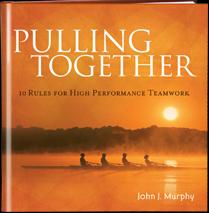 An excerpt from Pulling Together by John J. Murphy
An excerpt from Pulling Together by John J. Murphy
Can you imagine competing in an athletic contest without open access to the score, the clock and the playbook? How about competing in battle without clear tactical plans and timely communication? Looking to buy a product or commission a service? How informed are the people you are considering?
Without factual information and timely, candid feedback, teams quickly dissolve into weak, dependent groups, shifting responsibility and ownership for problems to those who are informed. In many organizations, this results in a crippling “dependency syndrome,” an upward delegation of problem-solving and conflict resolution. Got a problem? Give it to the boss to solve!
High performance teams are empowered teams and information is a source of great power.
With it, people can take ownership and act responsibly.
Without it, people are captive. They are in the dark, doubtful about what to do and where to go.
To empower a team, begin by sharing information.
What are the key metrics and performance indicators for the team?
What do team members need to know on a daily, weekly and monthly basis to manage performance responsibly?
How do team members know the score without asking?
While timely, candid feedback may not always be pleasant, it is necessary for any team to grow and adapt and to learn quickly from mistakes. Feedback can be verbal or visual to be effective, but never underestimate the power of “self-discovery.” This means designing and developing methods for team members to assess performance for themselves, without micro-management. Using self-discovery methods such as video feedback or graphical charts that show relative performance allows team members to judge their own performance in comparison to goals, standards, trends and/or metrics. This approach to “score-keeping” creates focus, generates enthusiasm and helps keep the team aligned. Now stop and ask yourself:
How well do you know the score?
To learn more about Pulling Together, please click here!
Reprinted by permission of Simple Truths (c) 2011. In order to protect the rights of the copyright holder, no portion of this publication may be reproduced without prior written consent. All rights reserved.

